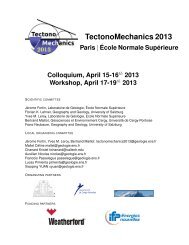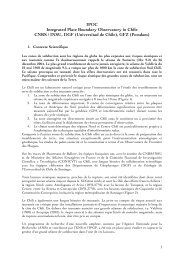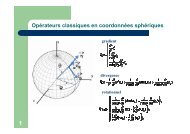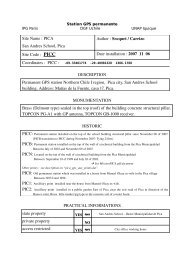PDF file - Laboratoire de Géologie de l'Ecole normale supérieure - Ens
PDF file - Laboratoire de Géologie de l'Ecole normale supérieure - Ens
PDF file - Laboratoire de Géologie de l'Ecole normale supérieure - Ens
You also want an ePaper? Increase the reach of your titles
YUMPU automatically turns print PDFs into web optimized ePapers that Google loves.
VIGNY ET AL.: GEODETIC MEASUREMENTS MONITOR ASAL RIFT DEFORMATION<br />
than the Nuvel-1A rate [Vigny et al., 2006]. This<br />
<strong>de</strong>finition of the Arabia plate implies that two stations<br />
located at the southern tip of the Danakil block (TDJ0<br />
and RSB0) are close to having “Arabian” velocities<br />
(figure 1). Their residual motion with respect to the<br />
four stations in Yemen is less than 2 mm/yr. This<br />
confirms that the opening rate of the Red Sea at this<br />
latitu<strong>de</strong> is negligible, which is not surprising given the<br />
absence of magnetic anomalies on the sea floor there.<br />
Therefore, we conclu<strong>de</strong> that most (possibly all) of the<br />
present day opening is accommodated west of the<br />
“Danakil block” represented by RSB0 and TDJ0<br />
(figure 1).<br />
With respect to the African plate <strong>de</strong>fined in [Vigny<br />
et al., 2006] (50.48°N, -82.01°W, 0.265°/Myr) the<br />
motion of these 2 points (RSB0 and TDJ0) is 15±2<br />
mm/yr oriented N54±6°. Assuming that the Danakil<br />
block rotates about a pole near its northern end (at<br />
16°N, 40°E), we find an angular velocity of 1.6 ± 0.1<br />
°/Myr for the Danakil block. This rate compares very<br />
well with paleomagnetic rotations in the area (10.7° ±<br />
4° over 7 Ma), which give an average spin rate of 1.5<br />
± 0.6 °/Myr or 26 ± 10 mrad/yr [Manighetti et al.,<br />
2001a, Besse and Courtillot, 1991]. Therefore, we<br />
conclu<strong>de</strong> that the fact that the opening of Arabia-<br />
Africa at this latitu<strong>de</strong> is absorbed west of the “Danakil<br />
block”, (i.e. along the <strong>de</strong>formation zones of the Afar<br />
<strong>de</strong>pression) can be exten<strong>de</strong>d to the last 7 Ma at least.<br />
Djibouti and the gulf of Tadjoura<br />
Deformation along the northern si<strong>de</strong> of the Gulf of<br />
Tadjoura (Figure 2) exhibits a clear gradient from 16<br />
mm/yr on the north-eastern Asal-Ghoubbet rift<br />
shoul<strong>de</strong>r to 11 mm/yr in the Danakil block (RSB0,<br />
TDJ0). Stations FFF0, MMM0, and RRR0, lying at<br />
the same distance of the Asal-Ghoubbet rift axis,<br />
display a particularly coherent velocity (16 ±1 mm/yr<br />
and N45° ± 8° on average). We are particularly<br />
confi<strong>de</strong>nt in the velocity of point FFF0 since it has<br />
been measured four times during the last 12 years,<br />
with a remarkably stable time series. Point PPP0,<br />
located at intermediate distance between the “Danakil-<br />
Arabian” area and the rift shoul<strong>de</strong>r, has a transitional<br />
velocity of 15 ±3 mm/yr with the same azimuth.<br />
On the southwestern si<strong>de</strong> of the Asal-Ghoubbet<br />
rift, we observe no significant velocity gradient<br />
between the southern rift shoul<strong>de</strong>r (CCC0 or QQQ0)<br />
and the Somalia plate as we have <strong>de</strong>fined it. Yet this<br />
interpretation is subject to two caveats: First, there are<br />
no sites between GOR0 in the far-field and the<br />
southern rift shoul<strong>de</strong>r. Second, the motions of QQQ0<br />
and III0 differ markedly: the former has a small<br />
insignificant residual velocity while the latter has an<br />
unexpected and probably erroneous high velocity of<br />
10 mm/yr. Despite these caveats, we infer an<br />
asymmetry in the extensional <strong>de</strong>formation pattern<br />
between the northern part and the southern part of the<br />
Asal-Ghoubbet rift. This asymmetry is also apparent<br />
in the vertical <strong>de</strong>formation recor<strong>de</strong>d by the<br />
5<br />
Figure 2. Djibouti and Gulf of Tadjoura. Dots show<br />
locations of GPS stations. Arrows <strong>de</strong>pict their horizontal<br />
velocities with respect to a reference frame fixed on the<br />
Somalia plate. Bold numbers asi<strong>de</strong> the arrows indicate the<br />
velocity in mm/yr. Ellipses <strong>de</strong>pict the region of 99%<br />
confi<strong>de</strong>nce using the uncertainties in Table 1. Thick black<br />
lines show the principal directions of active rifting<br />
(Mak'Arassou, Asal-Ghoubbet, Gulf of Tadjoura) and the<br />
Maskali transform fault. Thin grey lines <strong>de</strong>pict faults in<br />
the Asal-Ghoubbet rift.<br />
topography, the faults activated during the 1978<br />
sequence, and individual faults shifting their activity to<br />
the northeast [Ruegg et al., 1990; Stein et al., 1991;<br />
Ruegg and Kasser, 1987].<br />
All these results confirm that most of, and in fact<br />
more than, the present motion of Arabia-Somalia is<br />
absorbed in the Asal-Ghoubbet rift during the 12-year<br />
observation period. In particular, no <strong>de</strong>formation can be<br />
<strong>de</strong>tected in the Tadjoura rift or attributed to the faults<br />
located between the Tadjoura rift and the Asal rift,<br />
<strong>de</strong>spite the sparse GPS network along the Gulf of<br />
Tadjoura. Nor do we see any evi<strong>de</strong>nce for slip or creep<br />
on the <strong>de</strong>nse Gagga<strong>de</strong>-Hanle active fault system,<br />
southwest of Asal rift. Accordingly, we infer that the<br />
faults there are locked during this period.<br />
Why, then, is the extension rate of 16mm/yr across<br />
the Asal rift some 50% faster than the Arabia-Somalia<br />
plate motion? The most probable explanation involves<br />
the transient processes that took place in the rift<br />
following the 1978 seismo-volcanic sequence, when up<br />
to 1.9 m of extension were measured across the rift<br />
[Ruegg et al., 1979]. During the following <strong>de</strong>ca<strong>de</strong>,<br />
extension at a rate of 60 mm/yr has been measured<br />
across the inner rift fault system that has been activated<br />
during the 1978 sequence [Ruegg and Kasser, 1987].<br />
After 1987 this rate <strong>de</strong>creased to about 1 cm/yr, smaller<br />
than the far field rate imposed by large-scale plate<br />
tectonics (Figure 3). That the rate of opening changed<br />
drastically in the 6 years following the 1978 rifting<br />
event suggests two possible interpretations.<br />
In the first interpretation, the opening continued at a<br />
constant rate of 53 mm/yr from 1980 through 1986






